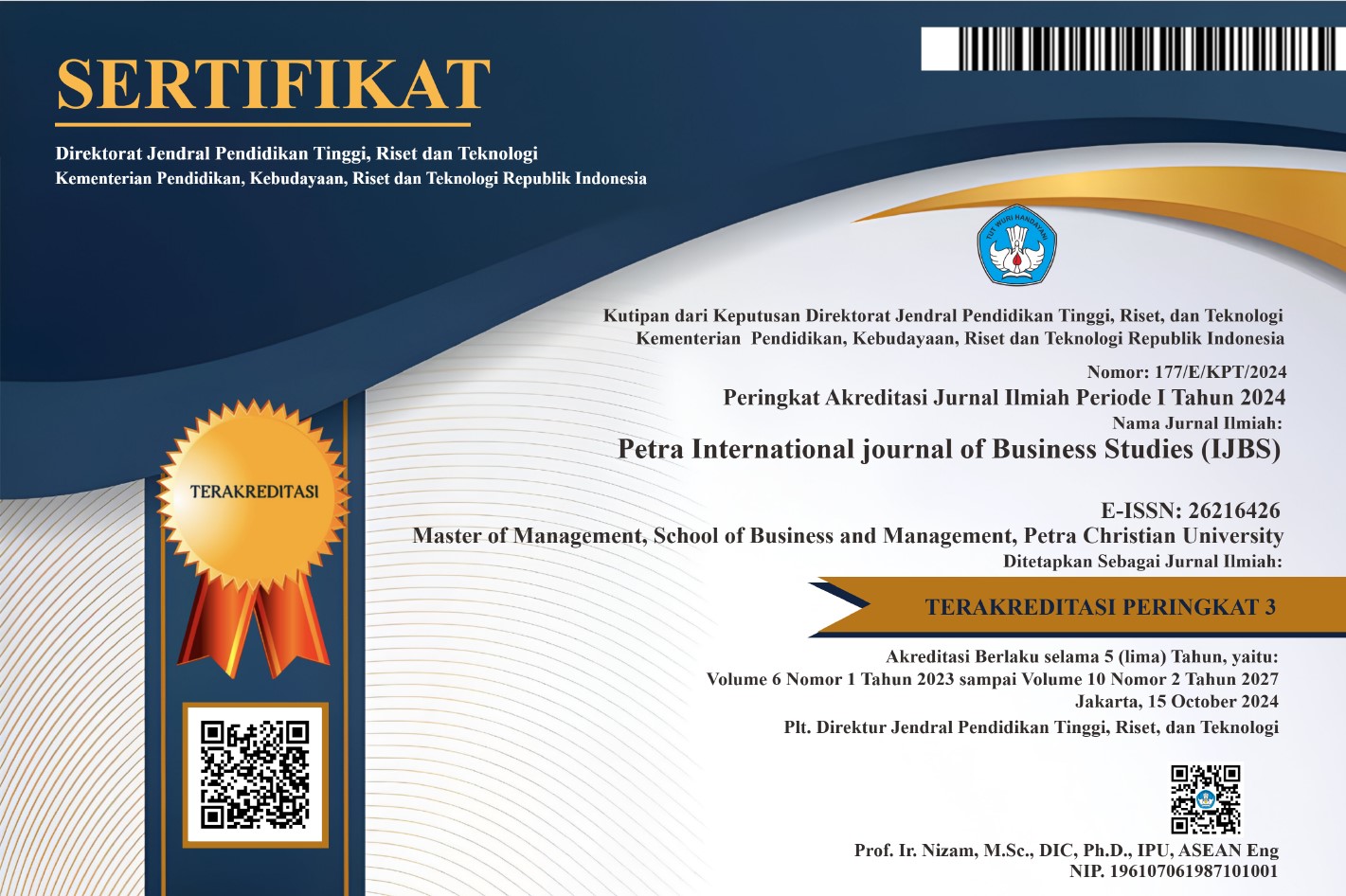The Effect of Information Technology Application on Organizational Performance Through Cross Functional Team and Total Quality Management Implementation
DOI:
https://doi.org/10.9744/ijbs.1.2.98-105Keywords:
Information Technology Application; Total Quality Management Implementation; Cross Functional Team; Organizational PerformanceAbstract
In this thesis discuss the effect of Information Technology Application on Organizational Performance through Cross Functional Team and Total Quality Management Implementation on the company. In this study using primary data with 102 population and 50 samples of manufacturing companies using data collection methods, namely 5 points Likert scale in the form of questionnaires distributed in companies that are open or closed that have large and medium industrial groups on firm manufacturing in East Java. This study uses Structural Equation Modeling analysis techniques, also called path modeling with SmartPLS tools. The questionnaire collected was 57 questionnaires. The result showed that the effect of Information Technology Application on Organizational Performance was significant. The results showed that the effect of Information Technology Application on Cross Functional Team was significant, the result showed that the effect of Information Technology Application on Total Quality Management Implementation was significant, the result showed that the effect of Cross-Functional Team on Organizational Performance was significant, the result showed that the effect of Cross-Functional Team on Total Quality Management Implementation was significant and the result showed that the effect of Total Quality Management Implementation on Organizational Performance was significant in firms manufacturing in East Java.
Downloads
References
Bessen, J. (2002). Technology adoption costs and productivity growth: The transition to information technology. Review of Economic Dynamics, 5(2), 443–469.
Bo Bergman and Bengt Klefsjo. (2007). Quality from Customers Needs to Customer Satisfaction” Bo Bergman Bengt Klefsjo, 1994 Lund (Sweden).
Chen, C.-J. (2007). Information Technology, Organizational Structure, and New Product Development---The Mediating Effect of Cross-Functional Team Interaction. IEEE Transactions on Engineering Management, 54(4), 687–698.
David N. Burt, Sheila D.Petcavage, R. L. P. (2010). Supply Management (Eighth Edi). New York: McGraw-Hill/Irwin.
Foster, S. T., & Gallup, L. (2002). On functional differences and quality understanding. Benchmarking: An International Journal, 9(1), 86–102.
Gaspersz, V. (2001). Total Quality Management. Bogor: PT Gramedia Pustaka Utama.
Ghozali, I., & Latan, H. (2015). Partial least squares: Konsep, teknik dan aplikasi menggunakan program SmartPLS 3.0 untuk penelitian empiris. Semarang: Badan Penerbit UNDIP.
Hermano, V., & Martín-Cruz, N. (2016). The role of top management involvement in firms performing projects: A dynamic capabilities approach. Journal of Business Research, 69(9), 3447–3458.
Huang, K.-E., Wu, J.-H., Lu, S.-Y., & Lin, Y.-C. (2016). Innovation and technology creation effects on organizational performance. Journal of Business Research, 69(6), 2187–2192.
Ishak, & Jusang, B. (2005). Kemahiran Komunikasi Antara Perseorangan.
Kalkan, A., Erdil, O., & Çetinkaya, Ö. (2011). The relationships between firm size, prospector strategy, the architecture of information technology and firm performance. In Procedia - Social and Behavioral Sciences (Vol. 24, pp. 854–869).
Karia, N., & Hasmi Abu Hassan Asaari, M. (2006). The effects of total quality management practices on employees’ work‐related attitudes. The TQM Magazine, 18(1), 30–43.
Kaynak, H. (2003). The relationship between total quality management practices and their effects on firm performance. Journal of Operations Management, 21(4), 405–435.
Koufteros, X. A., Edwin Cheng, T. C., & Lai, K. H. (2007). “Black-box” and “gray-box” supplier integration in product development: Antecedents, consequences and the moderating role of firm size. Journal of Operations Management, 25(4), 847–870.
Martínez-Lorente, A. R., Sánchez-Rodríguez, C., & Dewhurst, F. W. (2004). The effect of information technologies on TQM: An initial analysis. International Journal of Production Economics, 89(1), 77–93.
Nguyen, N. P., Ngo, L. V., Bucic, T., & Phong, N. D. (2017). Cross-functional knowledge sharing, coordination and firm performance: The role of cross-functional competition. Industrial Marketing Management, (May 2016), 0–1.
Papke-Shields, K. E., & Malhotra, M. K. (2001). Assessing the impact of the manufacturing executive's role in business performance through strategic alignment. JOURNAL OF OPERATIONS MANAGEMENT, 19(1), 5–22.
Pawar, K. S., & Sharifi, S. (2000). Virtual collocation of design teams: coordinating for speed. International Journal of Agile Management Systems, 2(2), 104–113.
Prashar, A. (2017). Adopting the PDCA (Plan-Do-Check-Act) cycle for energy optimization in energy-intensive SMEs. Journal of Cleaner Production, 145, 277–293.
Randeree, K., & Al Youha, H. (2009). Strategic Management of Performance: An Examination of Public Sector Organizations in the United Arab Emirates. The International Journal of Knowledge, Culture, and Change Management: Annual Review, 9(4), 123–134.
Sila, I. (2007). Examining the effects of contextual factors on TQM and performance through the lens of organizational theories: An empirical study. Journal of Operations Management, 25(1), 83–109.
Suwandej, N. (2015). Factors Influencing Total Quality Management. Procedia - Social and Behavioral Sciences, 197, 2215–2222.
Trent, R. J. (2003). Planning to use work teams effectively. Team Performance Management: An International Journal, 9(3/4), 50–58.
Vitale, M. (2002). WHAT IT INFRASTRUCTURE CAPABILITIES ARE NEEDED TO I IMPLEMENT E-BUSINESS, 1(1), 17–34.
Additional Files
Published
Issue
Section
License
Petra IJBS (e-ISSN: 2621-6426) is published by Master of Management program, School of Business and Management, Petra Christian University, Indonesia (MM SBM PCU).












